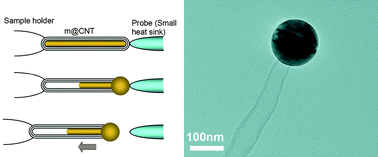Metal-filled carbon nanotube based optical nanoantennas: bubbling, reshaping, and in situ characterization
Abstract
Controlled fabrication of metal nanospheres on

* Corresponding authors
a
Department of Electrical and Computer Engineering, Michigan State University, East Lansing, MI 48824, USA
E-mail:
ldong@egr.msu.edu
Fax: +1 517 353 1980
Tel: +1 517 353 3918
b College of Chemical Engineering and Materials Science, Zhejiang University of Technology, Hangzhou 310014, China
c Department of Material Science and Technology, Research Center of Laser Fusion, China Academy of Engineering Physics, Mianyang, Sichuan 621900, China
d Center for Advance Microscopy, Michigan State University, East Lansing, MI 48824, USA
e Department of Materials Science and Engineering, Zhejiang University, Hangzhou 310027, China
Controlled fabrication of metal nanospheres on

 Please wait while we load your content...
Something went wrong. Try again?
Please wait while we load your content...
Something went wrong. Try again?
Z. Fan, X. Tao, X. Cui, X. Fan, X. Zhang and L. Dong, Nanoscale, 2012, 4, 5673 DOI: 10.1039/C2NR30892D
To request permission to reproduce material from this article, please go to the Copyright Clearance Center request page.
If you are an author contributing to an RSC publication, you do not need to request permission provided correct acknowledgement is given.
If you are the author of this article, you do not need to request permission to reproduce figures and diagrams provided correct acknowledgement is given. If you want to reproduce the whole article in a third-party publication (excluding your thesis/dissertation for which permission is not required) please go to the Copyright Clearance Center request page.
Read more about how to correctly acknowledge RSC content.
 Fetching data from CrossRef.
Fetching data from CrossRef.
This may take some time to load.
Loading related content
